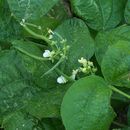Brief Summary
provided by EOL authors
Phaseolus vulgaris, the green bean, kidney bean, or common bean, is an herbaceous annual plant in the Fabaceae (legume or bean family) that originated in Central and South America and is now cultivated in many parts of the world for its beans, which can be harvested and eaten immature, still in the edible pod, or when mature, shelled, and dried. Numerous cultivars of green beans have been developed, including string beans, stringless varieties (such as the slender French haricot varieties), and snap beans. Cultivars of dried (or shelling) beans from this species are even more diverse, among them the following: black beans (or black turtle beans); cranberry beans (tan speckled with maroon, or white speckled with crimson); kidney beans (which may be light or dark red, and come in various sizes); cannellini or white kidney beans; pinto beans (the speckled varieties used in many Latin American dishes); and various white beans (also called navy beans). P. vulgaris appears to have been domesticated in two separate events, with the development of a large-seeded type, developed in Peru around 8,000 years ago, and a smaller-seeded type, developed in Mexico around 7,000 years ago. By the time Europeans arrived, beans were cultivated throughout the New World, in North America as well as Central and South America. P. vulgaris varieties have been developed to have both bush and twining forms. The bush forms, which grow in erect leafy clumps, reach 1 m (3.25 ft) tall, while twining forms, which need to be supported with poles or trellising, grow up to 4 m (13 ft) long. Plants have trifoliate compound leaves with oval to rhombic leaflets, each up to 16 cm (9.25 in) long, which are pubescent (covered with downy hair). The flowers, which may be white, yellow, violet, or red, in loose, open unbranched clusters (racemes) that are shorter than the leaves, and develop into linear round to slightly flattened pods up to 15 cm (6.75 in) long. Green beans, which are high in vitamin C and dietary fiber, are occasionally served fresh in salads but are more often prepared as a cooked vegetable. Green beans are often sold canned or frozen. Dried beans from this species, harvested when the pods have fully matured and dried, may be sold dry or already partially cooked and canned, are high in protein, vitamins B and C, and various minerals (including iron, magnesium, phosphorus, and potassium). Dried beans are soaked and cooked for several hours, and cooked into numerous soups, stews, and meat dishes, including French cassoulet, Mexican frijoles, North American chili (or chili con carne), and the Brazilian black bean feijoada. Dried beans, including this species, are an important source of protein in many parts of Africa, southeast Asia, and South America. The U.N. Food and Agricultural Organization estimates that total commercial production of dried beans (which includes numerous varieties of P. vulgaris but also includes some beans of other species, including P. lunatus, but does not include green beans) was 23.23 million metric tons worldwide in 2010, harvested from 29.92 million hectares. India was the leading producer, responsible for 21% of total production, followed by Brazil, Myanmar, China, the U.S., and Mexico. Within the U.S., the major dried-bean producing states in 2007 were North Dakota, Michigan, Nebraska, Minnesota, and Idaho. (Bailey et al. 1976, FAOSTAT 2012, USDA 2012, van Wyk 2005.)
Three Sisters intercropping
provided by EOL authors
By the time Europeans arrived, Phaseolus vulgaris beans were cultivated throughout the New World, in North America as well as Central and South America. They were widely used in combination with two other New World crops (corn, Zea mays, and squashes or pumpkins, Cucurbita species) in a combination often referred to as the Three Sisters, in which the plants grow in mutually beneficial ways (providing nutrients, structure, and shade from competitors for each other), and providing complementary food sources for complete human nutrition, because the squash and beans supply amino acids not found in corn, including lysine and tryptophan, but needed for a complete protein. (Hedrick 1919, Wikipedia 2012.)

